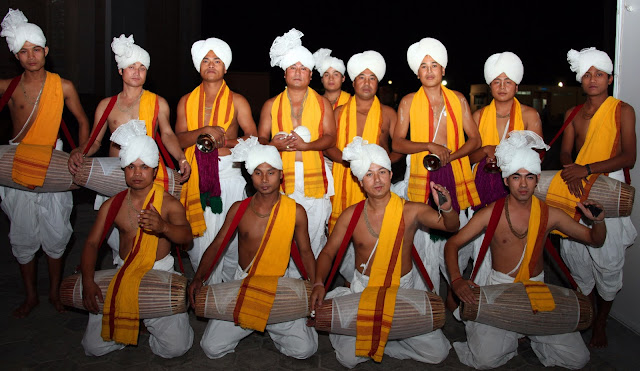PALA KOKYET : A type of turban used by the Meiteis!
 |
| Sankritanas palas with their Pala Kokyet |
PALA KOKYET
In Manipuri, “kokyet”means turban. Turban culture developed remarkably among the Meiteis. The used of turbans differed significantly in style and according to the purpose of the use and occasion. Pala kokyet is also one of the important turban used in the Meitei society. It is the form of turban put on as the name so suggests, by the Pala, that is , sankritana. It is also called Kokyet phisang since it is made of Khudup Niphu(that is , forty arm length of cloth, hence the name “phisang” implying “phi” meaning cloth and asangba means long one . Naturally , the turban made is quiet big and look like a ball. This form of turban is presumably the biggest of all turbans worn by the Meiteis . This mode of wearing turban is also used by the Pena singers( fiddle singers) who recites folk and legendary tale while playing a musical instrument locally called Pena (fiddle –liked stringed musical instrument).
How to fold?
The long and narrow yet thin cloth is first flattened into three equal folds measuring a width of three fingers . Both ends of the cloth are well tucked in and are hidden in the turban.the peculiarity in the preparation of this turban is that the cloth is flattened on the left side while the right side is scrolled when wrapped resembling the form of the end of a Tharoi (snail). Finally , a tuft of black yarn locally known as Petruk is inserted at the top of the head in the small gap provided for the purpose, in between the two ventral rounds of the turban.
 |
| Pala kokyet ( Front view) |
 |
| Pala Kokyet(Rear view) |
The origin of Pala kokyet may be traced back as late as the reign of Meidingu Charairongba who initiated the worship of Rama in the 18th century A.D. It got its popularity during the period of Maharaja Narasingha in the 19th century A.D. Maharaja Sir Chandrakirti Singh modified its forms to assume the present form of Pala Kokyet Achouba.


Comments
Post a Comment